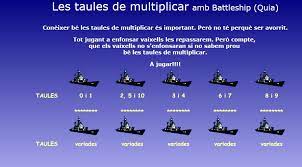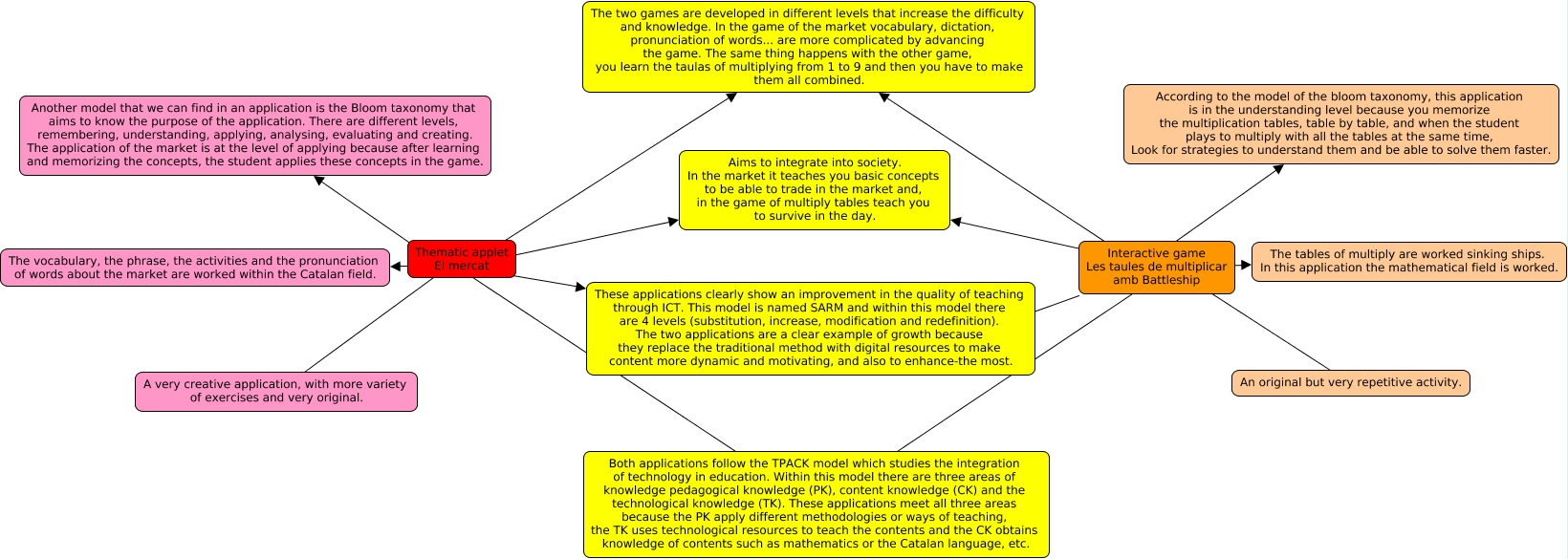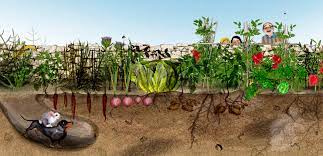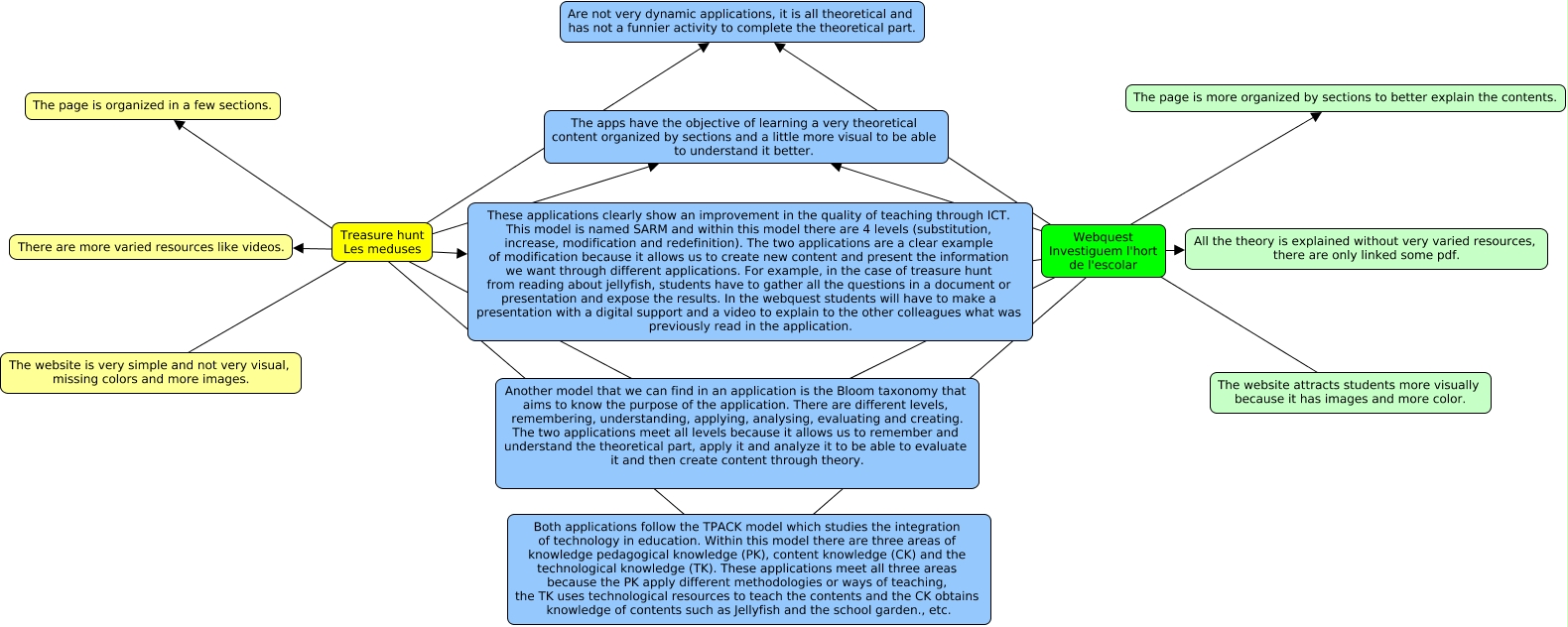Analysis of digital activities
This activity is divided in two parts; the analysis of the four applications and compare them and the analysis of the one application.
The first part consists mainly of knowing digital activities carried out or that could be used in primary education and relating them to the conceptual references seen in class theory (monograph - activities with digital technologies in school).
The objective of this activity is to choose four applications from which the teacher has given you in the activity and pair them. Once this is done, you have to find their differences and their similarities between couples so we can see how these applications are made and see their creation through the different innovation models. Seeing their differences and similarities we can see which is the most suitable to work the different contents you want in a class and make it more dynamic.
In these conceptual maps we can see the two pairs of applications that I have chosen to compare them.
First pair→ Thematic Applet with Interactive game.



- Second pair-> Webquest with Treasure hunt.



The second part consists in choosing an online project of the academic year 21-22 of the Lacenet page which we must highlight the most interesting and relevant aspects such as the curriculum that is worked, the change implied by the SAMR model and the taxonomy of Bloom. In addition, it will also be possible to identify the different types of knowledge of the TPACK model presented by the chosen project.
Here we can observe all the characteristics that this project has and value it.
This task is related to the dimension 1 and 2 and her descriptors.
Dimension 1--> Instruments and applications.
This dimension is based on the...
"Ability to use a variety of digital devices and their applications, efficiently and effectively, to process data (textual, digital and audiovisual) and produce text and multimedia documents, images, drawings, graphics, sounds and videos".
Descriptors...
-1.1. Use of digital technologies as a resource and strategy in teaching and learning processes.
-1.2. Selection of digital resources for the design of activities and lesson plans.
-1.3. Incorporation of digital technologies in coherence with the school's educational project and infrastructure.
-1.5. Use of digital technologies to attend to student diversity.
-1.6. Use of digital technologies in the tracking and assessment of students.
-1.7. Development of innovative methodologies with the use of digital technologies.
All descriptors have their indicators...
-Point 1.1. is a intermediate indicator which is based integrated use of the digital technologies in teaching-learning activities.
-Point 1.2 is an intermediate indicator which is based on elaborate lesson plans based on previously selected digital resources.
-Point 1.3. is a basic indicator which is based on knows the school spaces where digital technologies are available and how they function.
-Point 1.5. is a basic indicator which is based on uses digital technologies to increase motivation and facilitate learning of students with special needs.
-Point 1.6. is a basic indicator which is based on individually uses digital resources for mentoring and for tracking students' progress (meetings, attendance, evaluation, personal files...).
-Point 1.7. is a advanced indicator which is based on leads projects in which the incorporation of strategies and innovative methodologies in the use of the digital technologies are present.
Dimension 2--> Information processing and organization of work and learning environments.
This dimension is based on the...
"Skills related to the search and selection of information (on the Internet and local networks), its cognitive processing to transform it into knowledge and the organization of personal digital work and learning environments where we store the information we use or produce".
Descriptors...
-2.1. Knowledge and compliance to the norms of use of the resources, infrastructures and digital platforms
-2.2. Knowledge and use of the general software applied in the school
-2.3. Organisation of the digital technologies taking into account the different learning spaces.
-2.4. Involvement in school projects related to digital technologies
All descriptors have their indicators...
-Point 2.1. is an intermediate indicator which is based on ensures students make a responsible use of digital technologies in the school and apply the rules of use.
-Point 2.2. is an intermediate indicator which is based on proposes improvements on the school's software and/or proposes the incorporation of new software.
-Point 2.3. is an intermediate indicator which is based on adapts teaching-learning activities to the spaces and to the digital technologies within the school.
-Point 2.4. is an intermediate indicator which is based on takes active part in the school teams and brings his/her experience and expertise in the implementation of projects relates to digital technologies.
The information and communications technology (ICT) are necessary to be able to create a new form of communication and knowledge through the different applications or web pages provided by any internet platform.
These applications offer the possibility of studying in a more participatory, disengaged way and allow to apply the whole theory in a more dynamic and fun way.
In addition, it makes students adapt the possibility of adapting the contents of each one according to their needs.
In order to do this assessment I have used two applications: the Cmap tools and the Canva.
Cmap tools has helped me to explain the differences and similarities in a schematic and visual way since I consider it a very theoretical part. And, the Canva I have used it to explain the chosen project and all its characteristics.
Thanks to the digital resources that I have used has made this task much easier for me because I have invested a lot of time and it was a bit complicated.
To sum up, from my point of view I think that all these applications that I have analyzed are very productive to learn basic knowledge on certain topics which often, as a teacher, it is very difficult to explain to students and that they understand it. So, they themselves put into practice knowledge that they do not yet have but that with these applications they acquire them little by little and in a different and fun way.
One of my anecdotes is that sometimes, when I do a children's effort class and have homework, I try to explain to them how I was taught as a child but then I realize that they have other innovative ways which are much more difficult. I asked me whether the education system really is adapted to the needs of pupils and does not take into account the different difficulties they may have. We do have to adapt to society, but I do not think we have to learn the easy way to learn strategies that achieve the same objective that the new strategies.